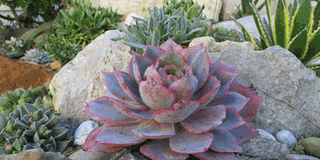Choose low-maintenance plants

Succulents can stand any type of weather conditions. All they need is prunning and weeding when necessary. Photo by Betty Ndagire
What you need to know:
- The compound. If you want compound plants that you do not have to care for all the time and yet they will make your home look nice, try to grow succulents.
- Remove any broken, dead, or diseased leaves or stems because they can cause weakening to the plant. A succulent with properly pruned branches will have improved structure and stability, aiding the plant in withstanding drier times
Succulent plants are plants whose leaves, stem or roots have the ability to retain water even in drought places.
There are about 60 different plant families which contain succulents.
The habitats of these water preserving plants are often in areas with high temperatures and low rainfall. Succulents have the ability to thrive on limited water sources, such as mist and dew, which makes them equipped to survive in an ecosystem which contains scarce water sources.
According to Stephen Ochan a landscaper, at Royalscape Landscaping and Maintenance Company Ltd, Entebbe, there are various types of succulents.
Leaf Succulents
The leaves of this type of succulent are entirely composed of water storage cells covered by a thin layer of photosynthetic tissue. These include plants such as Aloe Vera, spider lilies and lithops.
Stem Succulents
This type has fleshy stems containing water storage cells with the photosynthetic tissue. They do not have leaves, thereby reducing the surface area to prevent evaporative loss of water such as cactus, euphorbia milli and stapelia.
Root Succulents
These have roots which store water underground away from the heat of the sun. They shed their leaves during prolonged dry seasons. Others include, Caudiciform Succulents, Halophyte Succulents. Most of these plants are propagated by bulbs, bare root divisions and stolons.
For your exterior décor
Ochan says, “Succulents can best to be planted as contrasting plants in a garden design, edging plants along boundaries and walkways. Choose succulents with attractive colours and a soft leaf texture when dealing with walkways.”
Use succulents for shaded areas since most succulents easily adapt both in partial or fully shaded areas of a garden. Succulents such as the ‘red apple’ can be planted along raised grounds to form a mat system that checks erosion.
Succulent plants such as Cactus which grow up to a mature height of 10ft suit best as back drops in a garden design. Some best suit as center plants in plant groups.
“It is important to note that some gardeners have no idea of the characters and growth habits of these succulent plants, so seek proper advice from a qualified, landscaper, when choosing succulents. They can be found at flower nurseries in and around Kampala, Entebbe botanical gardens,” he says.
Significance
Succulents are never disappointing plants when fully established in a landscape; according to Ochan. They are drought tolerant plants, ever green and thrive in poor or infertile soils once fully established,
“Use them for contrasting plant patterns such as foliage and texture when arranging plants in a garden, as center plants and boundaries. Some succulents like the sensiviera (snake plant), are also good plants for keeping snakes away from your garden,” he says.
Some species such as the cactus are poisonous while others itch on contact, seek assistance from a qualified landscaper for selection.
Succulent plants usually stand out from the rest of the plants; they can be used as center plants when placed with soft leaf texture around them putting into consideration colour, sunlight and water requirements.
Plant trailing succulents such as Aptenia (red apple) which thrive well along slopes and under shaded places, use them as ground cover instead of grass.
“Succulents also blossom when put in hanging baskets as potted plants.Pot succulents such as cactus which require very little attention when fully established and place them further from sitting areas and walkways.” Use succulents on raised beds and on rocky gardens blend them with other brightly coloured plants with similar requirements.
Basic care
Most succulents have fibrous rooting system, a root bulb, stem or leaves that store water for longer periods. So they may need very little water when fully established.
“Drought might not cause instant withering of succulents since they hold water. But it weakens its health and normal growth giving it a stunted growth and paving the way for insects and disease. You therefore must be vigilant for any scorches, brown edges or yellowing between veins,” says Ochan.
Organic mulching helps retain the moisture. Succulents can withstand heat caused by decorative stones placed around them, always remember to pull mulch off during rainy seasons to prevent rot and keep it on during dry spells.
Remove any broken, dead, or diseased leaves or stems because they can cause weakening to the plant. A succulent with properly pruned branches will have improved structure and stability, aiding the plant in withstanding drier times.




